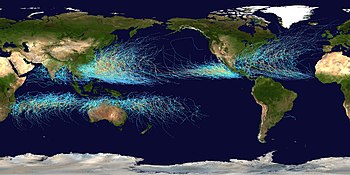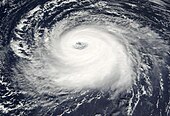
Back تكون الإعصار المداري Arabic Ciclogénesis tropical Spanish چرخندزایی حارهای Persian Cyclogénèse tropicale French Tropisk syklogenese NN Cyklogeneza tropikalna Polish Ciclogênese tropical Portuguese Tropical cyclogenesis SIMPLE การกำเนิดพายุหมุนเขตร้อน Thai Sự hình thành bão nhiệt đới Vietnamese

| Part of a series on |
| Tropical cyclones |
|---|
 |
|
Outline Media coverage |
Tropical cyclogenesis is the development and strengthening of a tropical cyclone in the atmosphere.[1] The mechanisms through which tropical cyclogenesis occur are distinctly different from those through which temperate cyclogenesis occurs. Tropical cyclogenesis involves the development of a warm-core cyclone, due to significant convection in a favorable atmospheric environment.[2]
Tropical cyclogenesis requires six main factors: sufficiently warm sea surface temperatures (at least 26.5 °C (79.7 °F)), atmospheric instability, high humidity in the lower to middle levels of the troposphere, enough Coriolis force to develop a low-pressure center, a pre-existing low-level focus or disturbance, and low vertical wind shear.[3]
Tropical cyclones tend to develop during the summer, but have been noted in nearly every month in most basins. Climate cycles such as ENSO and the Madden–Julian oscillation modulate the timing and frequency of tropical cyclone development.[4][5] The maximum potential intensity is a limit on tropical cyclone intensity which is strongly related to the water temperatures along its path.[6]
An average of 86 tropical cyclones of tropical storm intensity form annually worldwide. Of those, 47 reach strength higher than 74 mph (119 km/h), and 20 become intense tropical cyclones (at least Category 3 intensity on the Saffir–Simpson scale).[7]
- ^ "Definition for Cyclogenesis". Arctic Climatology and Meteorology. National Snow and Ice Data Center. Archived from the original on August 30, 2006. Retrieved October 20, 2006.
- ^ Goldenberg, Stan (August 13, 2004). "What is an extra-tropical cyclone?". Frequently Asked Questions: Hurricanes, Typhoons and Tropical Cyclones. Atlantic Oceanographic and Meteorological Laboratory, Hurricane Research Division. Retrieved August 30, 2008.
- ^ Landsea, Chris. "How do tropical cyclones form?". Frequently Asked Questions. Atlantic Oceanographic and Meteorological Laboratory, Hurricane Research Division. Retrieved October 9, 2017.
- ^ Landsea, Christopher. "AOML Climate Variability of Tropical Cyclones paper". Atlantic Oceanographic and Meteorological Laboratory. Retrieved September 23, 2010.
- ^ "Madden–Julian Oscillation". UAE. Archived from the original on March 9, 2012. Retrieved September 23, 2010.
- ^ Berg, Robbie. "Tropical cyclone intensity in relation to SST and moisture variability" (PDF). RSMAS (University of Miami). Retrieved September 23, 2010.
- ^ Chris Landsea (January 4, 2000). "Climate Variability table — Tropical Cyclones". Atlantic Oceanographic and Meteorological Laboratory, National Oceanic and Atmospheric Administration. Retrieved October 19, 2006.